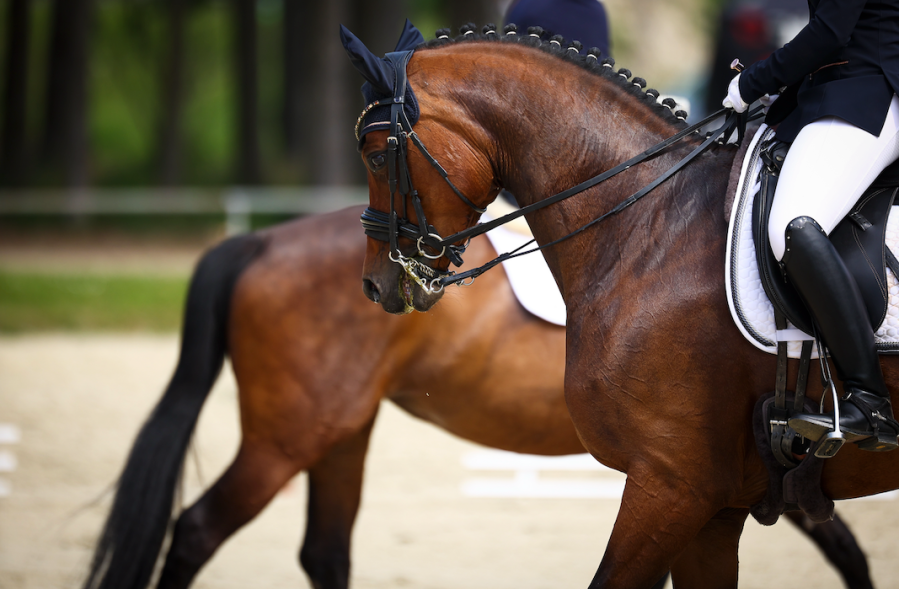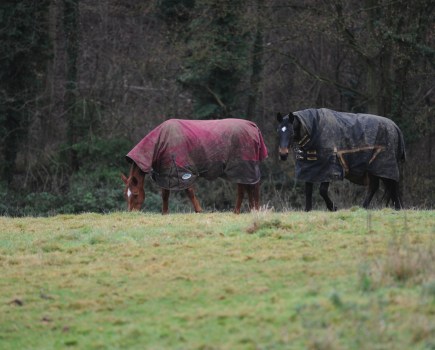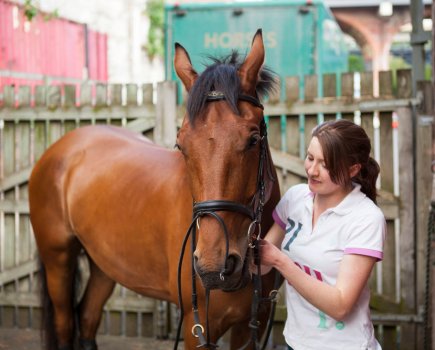Double bridles are a common sight in showing and at the higher levels of dressage. The key thing to understand about this item of horse tack is that it has two bits — the curb and the bradoon (snaffle) — and therefore two reins for the rider to hold. The top rein attaches to the bradoon, while the lower rein runs to the curb.
The design of a double bridle can vary and it’s important to recognise the different features and fixtures they can have. Different designs can have a huge effect on the way a double bridle works. In this article, we will explain what the key features are of a double bridle, how it works, how to hold the reins and how to fit it to your horse correctly.
Double bridles: the shank
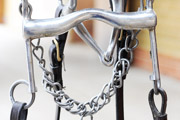
The curb has a port (curve) in the middle and curb chain at the back
The shank of the curb are the long sides of the bit which sit outside the horse’s mouth. It has a ring at the top to attach to the bridle; a smaller ring at the bottom attaches to the bottom rein.
The shank can be fixed or sliding and of varying lengths. A sliding shank allows the curb to move slightly when the bit tips due to the rider taking up the contact. This is less precise than a fixed shank but a much milder action. Shanks that are shorter in length also have a milder action.
Double bridles: the curb and port
The curb is one of the bits on a double bridle. In the middle of the curb is a curve, which is called a port. The curb sits in front of the second bit, which is called a bridoon. The action of the curb asks the horse to flex, while the thickness of the mouthpiece varies from bit to bit, as does the port in the centre.
A forward-slanting port can provide more room for the two bits to sit together nicely in the mouth. It is considered to be more comfortable on the horse’s tongue (especially in a fleshy mouth). The port should never touch the roof of the mouth. This would cause a lot of pain and discomfort for the horse.
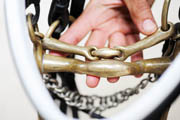
A double-jointed bradoon with a lozenge sits behind the curb
Ultimately the type of curb you need depends entirely on the make-up of your horse. Generally, the thicker the curb mouthpiece the milder the bit. A high port makes the bit more severe, but it really depends on your horse and what suits them and their mouth conformation best. A smaller mouth may require a thinner curb and smaller port, while a larger mouth may benefit from a thicker mouthpiece and a wider port. It is important to get it right, so seek advice from a specialist before you start riding in one.
Double bridles: the bradooon (snaffle)
The bradoon is a smaller version of a snaffle bit and its action asks the horse to lift his head. Commonly a single-jointed, loose-ring snaffle is used, but an eggbutt version can also be used. A double-jointed bit with a lozenge will sit neatly in the port of the curb for a more comfortable fit. The bradoon attaches to the top rein.
Double bridles: curb chain
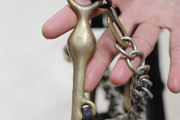
A curb chain with forward-facing hooks are best
The curb chain attaches at the back of the curb and does up on the other side, behind the horse’s mouth. The chain should lie flat in the chin groove and a padded chain cover can be used for extra comfort. You should also use a lip strap, which passes through the ‘fly link’ on the back of the curb chain. This helps to stabilise the curb chain and stops the horse from nipping at the shanks.
Curb chains can have forward- or backward-facing hooks. Forward-facing hooks are often a better choice though, because backward-facing hooks can become caught in the horse’s lip when putting the bridle on.
When to use a double bridle
“It would only be necessary to introduce a double bridle if your chosen discipline requires it,” says Diana Fisher, a Society of Master Saddlers master saddle fitter and qualified bridle fitter. “When introducing a double bridle, the horse needs to be able to accept the contact in a snaffle bridle and they should be able to show the early stages of collections — ie, simple changes, and demonstrating self-carriage and balance in counter-canter.”
How does a double bridle work?
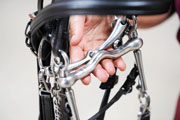
When putting on a double bridle hold both bits at the same time
The bradoon acts directly on the horse’s tongue, the bars of the mouth and the lips. It is the main rein for steering and restraining the horse. The curb should lie just below the bradoon and should be 0.5mm narrower.
“The action of the curb is determined by the size and shape of the ‘port’, which is the curve in the middle of the bit,” explains Diana. “A larger port allows the tongue to move into it, which, in turn, would put more action on the bars of the mouth. A lower port puts more action on the tongue itself.
“The longer the shanks on the curb, the greater the leverage, meaning the greater the rein pressure when applied by the rider. The action of the bits combined enables the rider to contain their horse’s collection and self-carriage through very subtle aids.”
How to fit a double bridle
According to Diana, the fit of a double bridle should be exactly the same as a snaffle bridle, preferably with a slightly cut-back headpiece around the base of the ears for comfort.
“The bradoon is usually attached with a strap known as a slip-head and a cheekpiece. The bradoon should be fitted the same as on a snaffle bridle, but it has smaller rings so that it’s not too cumbersome when combined with a curb bit,” she explains. “The curb bit should be fitted just below the bradoon, and both should be the correct width in the mouth. This means leaving about 1/8th of an inch of the curb visible on each side of the horse’s mouth.”
The height of the bradoon in the mouth should create one crease at the corner of the horse’s mouth. “The curb chain should sit in the curb groove under the chin, and should come into play when the curb shank is at a 45-degree angle,” adds Diana.
Putting on a double bridle
- If you’re doing this for the first time, start by holding the bridle up against the side of your horse’s head to see whether it’s roughly the right size.
- It’s important to treat the double bridle as a single bridle, and the two bits as one, as you put it on. This means holding them together and asking your horse to put them in their mouth at the same time.
- Put the reins over your horse’s neck and undo the curb chain.
- Hold the two bits in your hand, as you normally would, ensuring that the snaffle sits behind the curb. If you don’t do this, the snaffle can sit in the wrong place or twist.
- It’s also essential that the curb chain is secured at the right length, as it controls the severity of the curb bit. If it’s too loose it will allow the curb to rotate too far in the horse’s mouth, causing a lot of pressure on the tongue as the bit rotates forwards. Too tight and it will be uncomfortable for your horse.
- The curb chain should be fitted so that it acts when the lower cheek of the curb rotates to 45 degrees. If the curb chain is too short, the action of the curb bit is very severe and puts great pressure on the poll and the lower jar. A rough rider may even break the horse’s jaw bone.
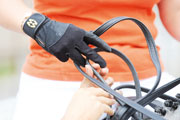
A double bridle will only work if you hold the reins correctly
How to hold two reins
A double bridle will only work if used correctly, and the secret is in how you hold the two reins. Holding the reins incorrectly will mean you’re likely to cause your horse to overbend, or you’ll feel some strong resistance to the contact.
- To use a double bridle most effectively, you must hold the snaffle rein as you would normally between your third (ring) finger and little finger.
- The curb rein should sit between your second and third finger.
- Then make a fist as you usually would, with your thumbs sitting on top of both reins, keeping them secure.
Learn the feel of double reins
To begin with, ride your horse on a 20m circle in walk, but ensure that the curb rein is slack so that you can first get used to the feeling of holding two reins. When you do take up the curb rein and walk on the circle, your seat bones should follow the movement, as normal.
You don’t follow the movement of your horse with your hands, you follow it with your hips. When you’re ready to shorten the curb rein, remember that your seat and legs will continue to work your horse into an outline. Your hands are to feel with the rein, but not fiddle. Remind yourself that the double bridle is only for fine tuning; it’s a very subtle action.
Before you ride in a double bridle for the first time, it’s a good idea to have a play with the action of the two bits from the ground. This gives you the opportunity to check that the horse is OK with this feeling too. Remember, the feeling of two bits in their mouth and the extra rein takes some getting used to.
Main image: copyright Shutterstock; other images: copyright Your Horse Library/Kelsey Media Ltd

